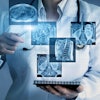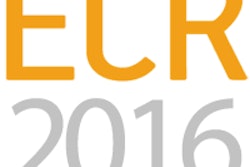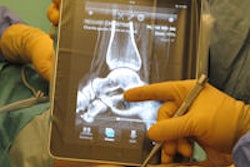Mobile computing technologies have the potential to reshape the practice of radiology, touching on areas such as interactions with referring physicians and other radiologists, image acquisition and transmission, education, and even patient care, according to an article in the December issue of Academic Radiology.
Although radiologists spend most of their time working at hardwired workstations, mobile computing offers many opportunities for radiologists to be more efficient and of greater service to referring clinicians and patients, noted lead author Dr. William Auffermann, PhD, an assistant professor of radiology at the Emory University School of Medicine.
Furthermore, "many applications of mobile computing to radiology can be achieved through existing technology," he told AuntMinnie.com.
As radiology utilizes the latest computers from image acquisition all the way to reporting, radiologists often find themselves as leaders in finding new uses for computers in medicine. In addition, the technical capabilities of current mobile devices and wireless networks are well within the requirements of many radiology applications, according to the team (Acad Radiol, Vol. 20:12, pp. 1495-1505).
"As hardware and display technologies continue to improve, mobile devices may find uses that expand the current paradigm of diagnostic medical imaging," the authors wrote.
Referring physicians
Applications for referring physicians include those that facilitate mobile computing.
"The care provider can work on a single personalized mobile computer device and not have to be concerned with finding an open desktop computer or varied desktop environments," the group wrote. "Healthcare professionals then have information pertaining to the imaging studies they will order or have ordered at their fingertips."
Computerized physician order entry (CPOE) is another area that could benefit from mobile computing. Available for hardwired computer terminals, such tools are not often accessible during physician interactions with patients, according to the authors.
"A CPOE tool available on a smartphone using a specialized application may facilitate physicians entering orders quickly and directly with less chance for errors (i.e., if the order is transcribed by physician support staff)," they wrote. "It follows that such a portal could lend itself to a readily accessible mobilized platform, yielding a higher quality of care through improved patient histories and more appropriate exam protocol."
In addition, the advent of smartphones and touchscreen devices open up avenues to advance the mobility of CPOE with clinical decision support (CDS), according to the authors.
"With all of the benefits of mobility offered by smartphone- and tablet-based CPOE, future physicians would have a veritable 'super tool' of evidence-based clinical support and order entry quite literally at their fingertips," they wrote.
Down the road, these systems could include speech recognition software combined with personal assistant software similar to Apple's Siri application, enabling referring physicians to query the application for the best choice of imaging study, according to the team.
Data acquisition and transmission
Along with improvements in wireless networks in recent years, advances in mobile computing technology and hardware offer the potential to revolutionize radiology image acquisition and transmission, according to the authors.
For example, radiographers may be able to transmit images to a PACS from the patient's bedside, minimizing the delay between image acquisition and availability on the PACS. Although this technology is already used in practice to a limited extent, it's not yet commonly used clinically, they noted.
"While it may not necessarily be efficient for the technologist to process/transmit the image and complete the modality performed procedure step for each image immediately after acquisition, this may be worthwhile for 'STAT' examinations or studies where the radiographer notices a critical abnormality on the image and rapid radiologist review is needed," they wrote.
Mobile computing devices could also be utilized for radiologists to remotely interact with sonographers as they perform ultrasound studies. In addition, exams from portable CT and MR units could be transmitted wirelessly over high-speed networks, according to the group.
These devices can also improve the workflow of radiologic technologists performing portable exams.
"The portable radiography and ultrasound units may potentially be equipped with computers showing a real-time list of requested portable examinations and their priority," the authors wrote. "This would eliminate errors in the oral communication of new exams and likely be more efficient. While such technologies are already available, they are not in general clinical use."
Mobile computing devices could also facilitate bringing radiology services to the patient. For example, smaller communities without stationary imaging facilities could be serviced by "mobile radiology departments." After imaging was performed at the local level, the studies could be sent via high-speed networks to radiologists.
"Such mobile departments would offer greater convenience to patients, as patients who are ill may be less inclined to make long trips when they could receive similar services in their own community," they wrote.
Radiologists
While current mobile device hardware and software can support mobile teleradiology, the exact role of mobile computing in this application remains unclear at this point. Although it's unlikely that radiologists will utilize mobile devices as their standard platform for image interpretation, mobile computing may be useful for facilitating fast evaluation of urgent imaging studies by on-call radiologists who are not at a hardwired PACS workstation, according to the group.
In addition, mobile devices can enable consultations among radiologists and between radiologists and referring physicians, the team noted.
"Mobile technology could facilitate bedside rounding with clinical teams or intraoperative discussions of imaging," the authors wrote. "By remotely accessing PACS, mobile computing could also promote social interaction between radiologists and clinical physicians and facilitate radiologist inclusion in the patient care team."
A radiology critical results notification application also could be installed on referring clinicians' smartphones, providing access to images or annotations and allowing radiologists to provide clinicians with a brief message, discussion, or video chat, according to the group.
Education
The use of mobile devices will impact a number of areas related to radiology education, such as e-books and journals, continuing medical education, resident assessment, online teaching conferences, and procedural training, according to the authors.
Thanks to its image-intensive content, radiology is well-suited to lead the development of mobile educational resources, and the rapid adoption of mobile technology is promising, they noted.
"A future dominated by novel electronic educational resources is on the horizon, resources that will immerse the user in an interactive dataset rather than static sample images," they wrote. "The ability to participate when a dedicated stationary desktop device is not available would facilitate participation."
Patient care
Mobile devices also show promise for impacting patient care. For example, these devices could be used for clinic logistics tasks such as appointment confirmations and patient check-in across Bluetooth, near field communication (NFC), or Wi-Fi. Once checked in, patients could review informational media about their procedure or exam, as well as receive patient satisfaction surveys, according to the authors.
In addition, mobile devices could be used by patients to access radiology reports on patient portals. Radiologists could also take advantage of mobile computing technology to encourage patients to learn about their disease process and management, they noted.
Overcoming barriers
Social as well as technological hurdles to acceptance must be cleared to support adoption of mobile devices in radiology applications. Hospital information technology departments will need to be involved in the planning stages to address obstacles such as a lack of familiarity with mobile technology; a need for standardization of information format and integration; information security; and demonstrating economic feasibility, according to the group.
Mobile technologies relating to patients show the most promise in the short- and midterm, Auffermann told AuntMinnie.com. As increasingly savvy consumers, patients will likely appreciate patient-centered mobile computing radiology applications.
"In the not too distant future, such applications may change from novel offerings to expected services," he said. "Greater patient access to their health information will continue to change the healthcare paradigm, with patients having increased involvement in their healthcare decision-making."
Taking a look well into the future, the authors predict that advances in information security and data encryption will enable safe transmission of protected health information to wireless devices.
"Requirements for securely accessing data may well be biometric identifiers such as a fingerprint or retina scan," the authors wrote. "There may be a standardized [electronic medical record] that allows all health systems to access a person's records from a central database so there is never redundancy or missing information."
The researchers emphasized that mobile computing technologies offer opportunities to improve patient care, while also facilitating the workflow of radiologists and referring physicians.
"Given modern radiology is a very technologically intensive field, we find ourselves the vanguard of clinical medicine as it seeks to adopt emerging mobile computing technologies," they concluded. "This position offers radiologists the opportunity to be leaders of this new era in medicine."




















